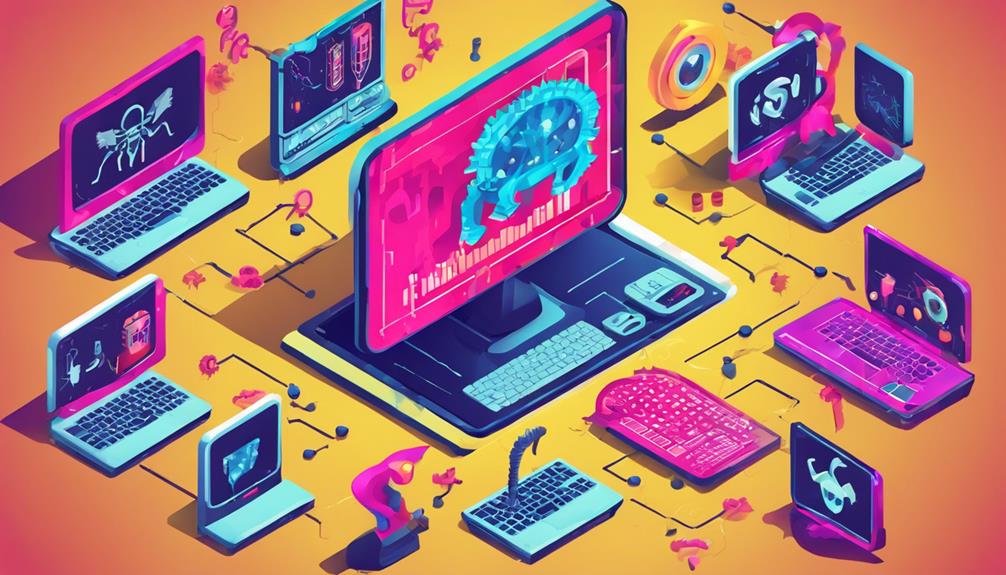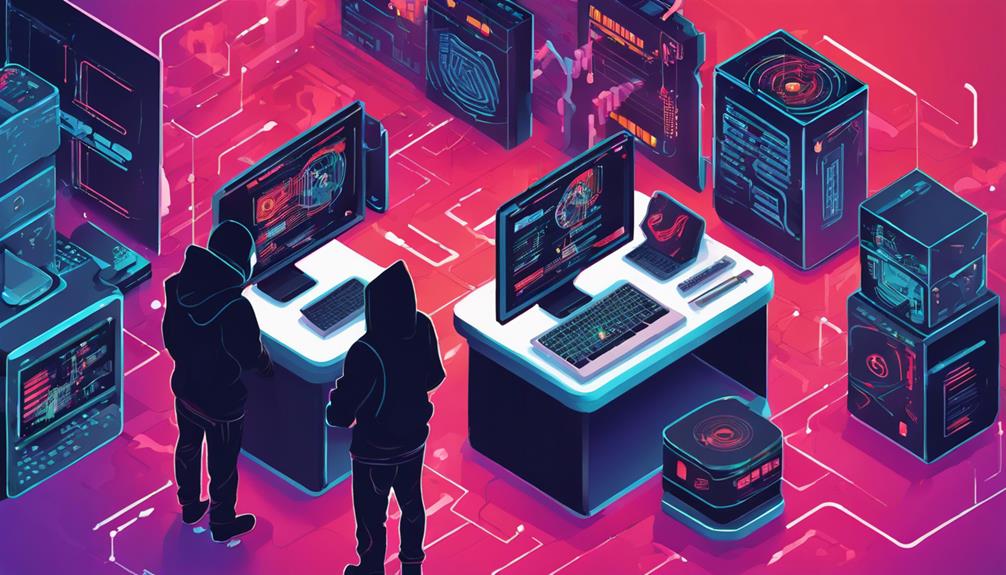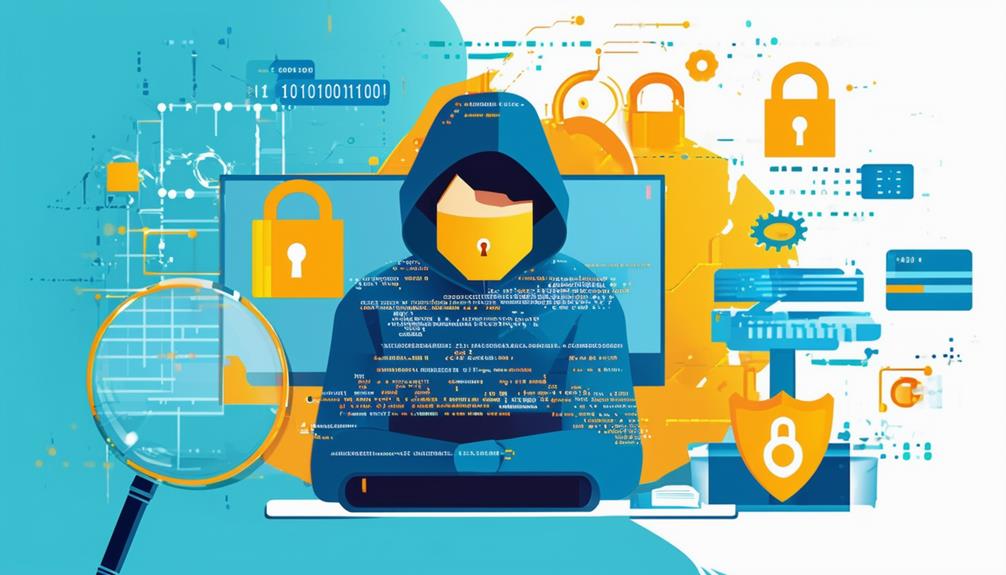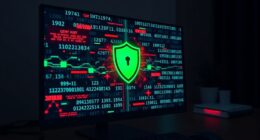Understanding viruses and worms is essential in cybersecurity. Viruses need user interaction to spread, while worms move autonomously through networks. Both carry harmful payloads. Creation methods vary from streamlined kits to manual coding. Malware types include Boot Sector, File System, Macro, Polymorphic, and Shell viruses. Targets range from Windows to Android, Mac, Linux, and iOS devices. Defenses include updating antivirus software, using strong passwords, cautious email practices, and regular data backups. Stay vigilant against these digital threats for robust protection.
Key Takeaways
- Viruses require user interaction to spread and replicate.
- Worms can automatically propagate through networks.
- Malware carries payloads with malicious code.
- Some worms exploit vulnerabilities like cross-site scripting.
- Understanding characteristics aids in cybersecurity defense strategies.
Characteristics of Viruses and Worms
Viruses and worms exhibit distinct characteristics that differentiate them as forms of malicious software. One key difference lies in their ability to spread.
Viruses require user interaction to replicate and spread, often by attaching themselves to legitimate files or programs. On the other hand, worms can automatically propagate through networks without the need for user action, making them particularly dangerous due to their rapid spread.
Additionally, viruses and worms carry payloads that can include malicious code or activities. These payloads can range from stealing sensitive information to causing system damage.
For example, some worms are designed to exploit vulnerabilities like cross-site scripting to infiltrate systems and execute malicious actions.
Understanding these characteristics is essential for developing effective cybersecurity strategies to combat viruses and worms. By recognizing how they spread and the potential harm they can cause, organizations can better protect their systems and data from these pervasive threats.
Creation Methods and Tools

In addition, the creation of malware involves utilizing various methods and tools to develop malicious software efficiently. Virus creation kits play a significant role in streamlining the process by offering pre-built components and functionalities, enabling even less experienced individuals to create malware.
Skilled programmers can also manually code malware, resulting in a wide array of unique and custom threats that target vulnerabilities in operating systems. With millions of new malware variants emerging daily, the landscape of malicious software continues to evolve rapidly.
Some malicious actors take advantage of pre-existing code snippets and modules to develop new threats more effectively. Additionally, the accessibility of tools and resources online has lowered the barrier for entry, allowing individuals with limited technical skills to engage in the creation and distribution of malware. This accessibility contributes to the proliferation of malware and underscores the importance of cybersecurity measures to combat these evolving threats effectively.
Types of Malware

Various forms of malware pose significant threats to computer systems, each targeting specific vulnerabilities and functions. Understanding the types of malware is vital in implementing effective security measures. Here are some common types of malware:
| Malware Type | Description | Example |
|---|---|---|
| Boot Sector Virus | Infects the boot sector of PCs, commonly spread through infected storage devices. | Stoned, CIH |
| File System Virus | Activates when specific files are executed, allowing them to spread through infected files. | Cascade, Vienna |
| Macro Virus | Runs on Microsoft Office documents, exploiting the macros feature to execute malicious code. | Melissa, Concept |
| Polymorphic Virus | Constantly changes its code structure with each replication, making detection and removal challenging. | Storm Worm, Conficker |
| Shell Virus | Resides in the kernel or shell of a computer, gaining control over system functions. | Bliss, Rugrat |
These types of malware can cause significant damage if not detected and mitigated promptly. It is essential to stay vigilant and employ robust security practices to safeguard against these threats.
Targets of Malicious Programs

Operating systems such as Windows, Android, Mac, Linux, and iOS are essential targets for malicious programs due to their varying levels of vulnerabilities and widespread usage. Malicious programs exploit these weaknesses to infiltrate devices and networks, causing harm and compromising sensitive information.
Some notable targets of malicious programs include:
- Windows Operating Systems: Widely targeted due to their prevalence and susceptibility to malware attacks.
- Android Devices: Vulnerable to malware spread through the Play Store and other app sources.
- Mac and Linux Systems: While less common targets than Windows and Android, they are not immune to malware threats.
- iOS Devices: Known for their stricter app store guidelines, making them less susceptible to viruses and worms compared to other operating systems.
Understanding the targets of malicious programs is crucial for implementing effective defense mechanisms and protecting devices and data from potential cybersecurity threats.
Defense Mechanisms and Best Practices

Effective defense against malware requires proactive implementation of security measures. Regularly updating antivirus software, using strong passwords, enabling firewalls, and being cautious with email attachments and links are essential practices to combat malware threats. Additionally, backing up important data frequently can help minimize the impact of potential malware attacks. However, one of the most critical defense mechanisms is keeping operating systems and software up to date.
To emphasize the importance of maintaining updated systems, the table below outlines the key reasons why this practice is vital in preventing malware vulnerabilities:
| Key Reasons for Updating Operating Systems |
|---|
| 1. Patches security flaws |
| 2. Enhances system performance |
| 3. Adds new features and functionalities |
| 4. Improves compatibility with software |
| 5. Ensures protection against emerging threats |
Frequently Asked Questions
What Are Worms in Ethical Hacking?
Worms in ethical hacking refer to self-replicating malware that spread independently across networks, exploiting vulnerabilities to infect devices. They can cause extensive damage by consuming bandwidth, slowing systems, and delivering malicious payloads.
What Is Ethical Hacker Salary?
Ethical hackers command competitive salaries, with figures varying based on experience levels. In the U.S., these professionals can earn an average of $92,000 annually. Certified Ethical Hackers (CEH) often secure higher pay than their non-certified counterparts.
What Is the Moral Code of the Hacker?
The moral code of a hacker centers on respecting privacy, avoiding harm, and using skills for positive purposes. Ethical hackers prioritize system protection, adhere to laws, obtain authorization, and disclose vulnerabilities responsibly to guarantee cybersecurity.
What Are Ethical Hackers Not Allowed to Do?
Ethical hackers, akin to surgeons who wield scalpels with precision, are not permitted to engage in unauthorized activities, including scanning, sniffing, or disclosing sensitive data without explicit consent. Upholding legal and ethical standards is paramount for trust and credibility.
Conclusion
To summarize, grasping the characteristics, creation methods, types, targets, and defense mechanisms of viruses and worms is essential in the world of ethical hacking.
By understanding your adversary, you can enhance the protection of yourself and your systems from malicious attacks.
Stay informed, stay vigilant, and stay secure.
Remember, knowledge is power in the battle against cyber threats.









